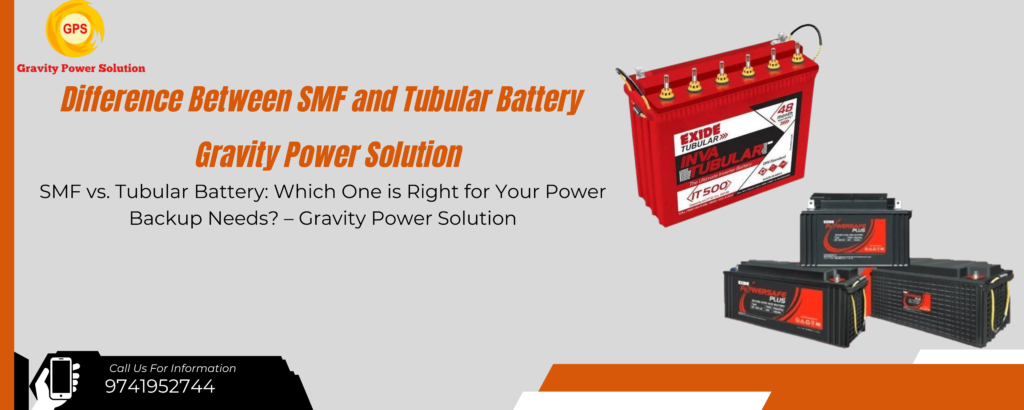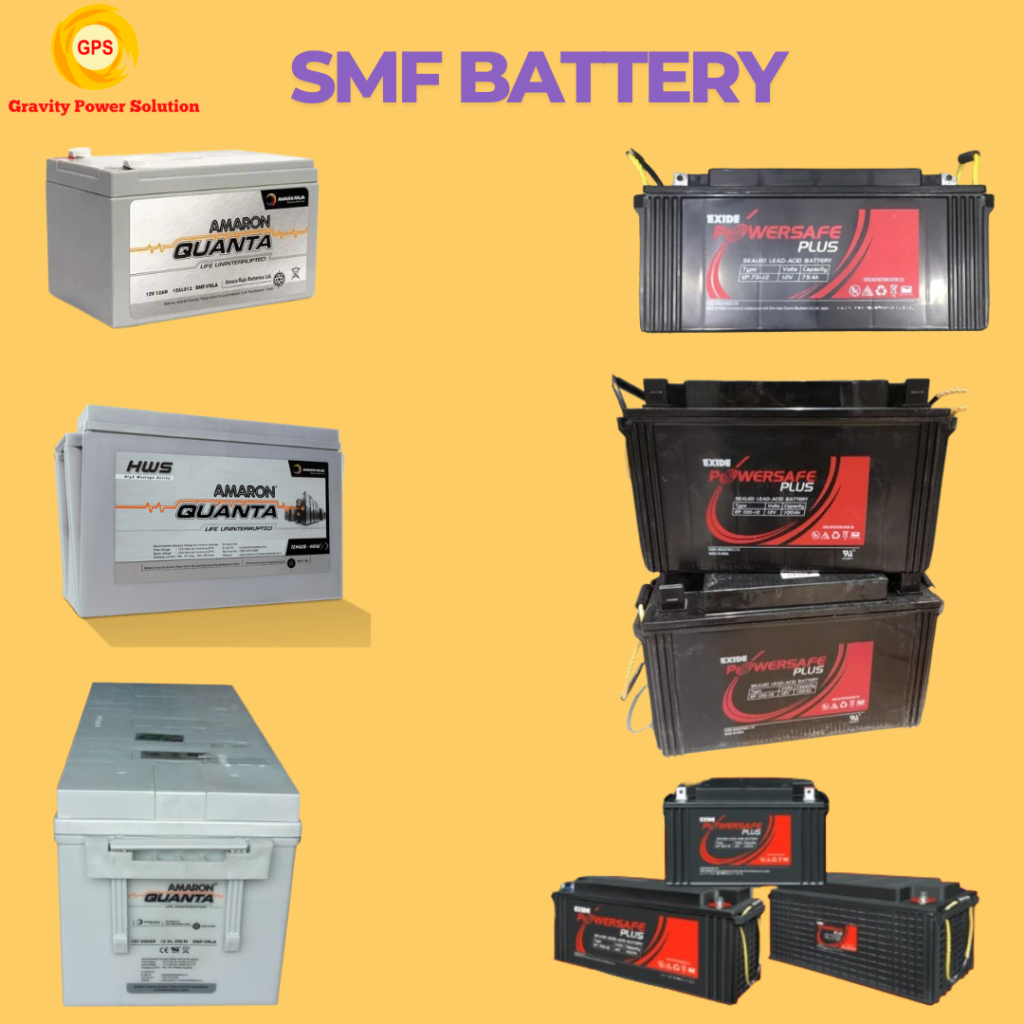
Difference between SMF and Tubular Battery – Gravity Power Solution
When choosing the right battery for your power backup system, it is essential to understand the key differences between SMF (Sealed Maintenance-Free) batteries and Tubular batteries. Both have unique advantages and applications. Let’s dive deep into the details.
What is an SMF Battery?
SMF battery is a Sealed Maintenance-Free lead-acid battery that does not require water topping or maintenance. It is also known as a VRLA (Valve Regulated Lead-Acid) battery. These batteries are completely sealed, preventing leakage or fumes, making them ideal for data centers, UPS backup, medical equipment, and telecom applications.
Key Features of SMF Battery:
- Maintenance-Free: No water topping or acid refilling is required.
- Sealed Design: Leak-proof and does not emit harmful gases.
- Compact & Lightweight: Smaller in size and easy to install.
- Faster Charging: Charges quickly compared to tubular batteries.
- Shorter Lifespan: Usually lasts 3 to 5 years.
- Best for UPS & IT Systems: Mostly used in UPS, servers, and electronic devices.
What is a Tubular Battery?
Tubular battery is a lead-acid battery designed with tubular positive plates, which enhances efficiency and durability. These batteries are widely used in inverters, power backup systems, and solar applications due to their longer lifespan and deep discharge cycles.
Key Features of SMF Battery:
- Longer Life: Typically lasts 5 to 10 years.
- High Efficiency: Performs well under deep discharge conditions.
- Better Heat Resistance: Ideal for high-temperature environments.
- Water Topping Required: Needs periodic maintenance.
- Bigger & Heavier: Requires more space for installation.
- Best for Inverter & Solar Use: Suitable for homes, offices, and industries.
Comparison Chart: SMF Battery vs. Tubular Battery


| Parameter | SMF Battery (VRLA) | Tubular Battery |
|---|---|---|
| Construction | Flat plates, sealed (VRLA/AGM design) | Tubular positive plates, flooded design |
| Maintenance | Maintenance-free, no water topping | Requires periodic water topping |
| Lifespan | 3 to 5 years | 5 to 10 years |
| Cycle Life | 200–300 cycles (80% DoD) | 1,000–1,500 cycles (80% DoD) |
| Depth of Discharge (DoD) | Up to 50% (safe limit) | Up to 80% (safe limit) |
| Charging Speed | Fast charging (6–8 hours) | Moderate charging (8–12 hours) |
| Usage | UPS, data centers, medical equipment | Home inverters, solar systems, industrial backup |
| Size & Weight | Compact & lightweight (15–30 kg) | Larger & heavier (30–150 kg) |
| Leakage Risk | No risk, completely sealed | Risk of spillage if not handled properly |
| Durability | Good for IT applications | Highly durable for power backup needs |
| Cost | Higher initial cost ($100–300) | More economical in the long run ($300–800) |
| Backup Duration | Moderate backup time | Longer backup time |
| Efficiency | 80–85% | 85–90% |
| Applications | Short backup for UPS, IT equipment, emergency power | Long backup for inverters, solar, and industrial use |
Detailed Comparison
1. Construction
- SMF Battery: Uses flat plates and a VRLA (Valve-Regulated Lead-Acid) design, making it completely sealed and maintenance-free.
- Tubular Battery: Uses tubular positive plates that provide better deep discharge capability, making it ideal for longer backup durations.
2. Maintenance
- SMF Battery: No need for water topping or periodic checks.
- Tubular Battery: Requires water topping at regular intervals to maintain performance.
3. Lifespan
- SMF Battery: Lasts 3–5 years under normal usage.
- Tubular Battery: Has a longer lifespan of 5–10 years, making it more cost-effective over time.
4. Cycle Life
- SMF Battery: Supports 200–300 charge/discharge cycles at 80% Depth of Discharge (DoD).
- Tubular Battery: Supports 1,000–1,500 charge/discharge cycles, meaning it can handle more charging and discharging over time.
5. Depth of Discharge (DoD)
- SMF Battery: It can be safely discharged at up to 50% capacity.
- Tubular Battery: Can be discharged up to 80%, meaning it provides a longer backup duration per charge.
6. Charging Speed
- SMF Battery: Charges faster (6–8 hours) due to its VRLA design.
- Tubular Battery: Takes 8–12 hours to charge fully due to its larger capacity and deep discharge characteristics.
7. Usage
- SMF Battery: Best for data centers, UPS systems, and medical equipment where quick charging and maintenance-free operation is essential.
- Tubular Battery: Best for inverter systems, solar energy backup, and industrial power solutions where longer backup is needed.
8. Size & Weight
- SMF Battery: Compact and lightweight (15–30 kg), making it easier to install.
- Tubular Battery: Larger and heavier (30–150 kg), requiring more space.
9. Leakage Risk
- SMF Battery: Completely sealed, so there is no risk of acid leakage or spills.
- Tubular Battery: Uses liquid electrolyte, which may leak if the battery is damaged or improperly handled.
10. Durability
- SMF Battery: Good for IT applications, but has a shorter life in extreme conditions.
- Tubular Battery: Highly durable, especially in high-temperature environments.
11. Cost
- SMF Battery: Has a higher initial cost ($100–300) but is suitable for applications that require quick replacement.
- Tubular Battery: Has a higher upfront cost ($300–800) but is cheaper in the long run due to its longer lifespan and deep cycle capabilities.
12. Backup Duration
- SMF Battery: Provides moderate backup, making it ideal for short power outages.
- Tubular Battery: Provides longer backup, making it better for areas with frequent or prolonged power cuts.
13. Efficiency
- SMF Battery: Operates at 80–85% efficiency.
- Tubular Battery: Operates at a slightly higher 85–90% efficiency, making it more effective in energy conversion.
14. Applications
- SMF Battery: Used in UPS, emergency power backup, medical equipment, telecom where reliability and compactness are important.
- Tubular Battery: Used in solar systems, inverters, and industrial power backup, where longer backup time is required.
Which One Should You Choose?
- If you need a battery for IT applications, medical equipment, or a UPS system, an SMF battery is the best choice due to its compact design and maintenance-free operation.
- If you require a battery for home inverter, solar applications, or industrial power backup, a Tubular battery is better as it offers a longer lifespan and supports deep discharge cycles.
Why Choose Gravity Power Solution?
Gravity Power Solution, we provide high-quality SMF and Tubular batteries from leading brands like:
🔹 Exide
🔹 Luminous
🔹 Amaron
🔹 Okaya
🔹 Livguard
📞 Contact Us Today ! 🌐 https://www.gravitypowersolution.com/ 📧 info@gravityups.in 📍 Bangalore | Chennai | Hyderabad | Kerala
